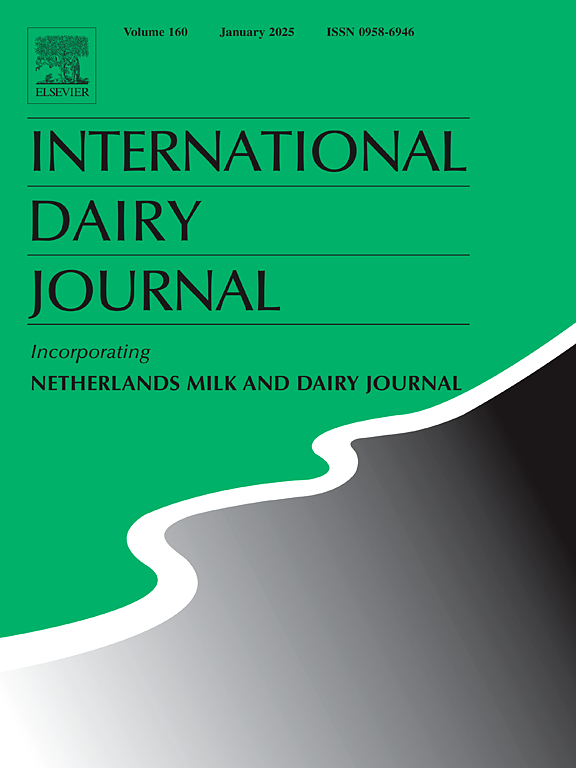Detection of urea adulteration in packaged milk samples using spatially-offset Raman spectroscopy
IF 3.4
3区 农林科学
Q2 FOOD SCIENCE & TECHNOLOGY
引用次数: 0
Abstract
Urea adulteration in milk is very rampant worldwide and its consumption can cause serious health hazards. Raman spectroscopy, because of its molecular-specificity, is a powerful analytical tool for biochemical assessment of the urea content in unpackaged milk samples. However, milk is commonly sold in packaged form. Hence, we report the development of a depth sensitive technique “inverse spatially-offset Raman spectroscopy” in combination with a multivariate statistical algorithm for the quantification of the urea adulteration in packaged milk samples. Limit of detection (LOD) and limit of quantification (LOQ) values were found to be 0.22 g/L and 0.67 g/L respectively. Hence, the method suitably detects all urea concentrations above the permissible limit of 0.70 g/L. For example, sample with urea concentration 0.75 g/L, have low Percentage Absolute Error (PAE) of ∼6 %, indicating that the urea concentration can be predicted with a high accuracy of ∼94 % using the developed technique. Further, the prediction accuracy follows an inverse relationship with the thickness of packaging material. The developed technique demonstrates quantification of urea in packaged milk samples, thereby advocating its potential for in-situ monitoring of urea adulteration in a milk production and packaging facility, as well as in the local vending outlets.
空间偏移拉曼光谱法检测包装牛奶样品中尿素掺假
在世界范围内,牛奶中掺入尿素的现象十分猖獗,饮用尿素会对健康造成严重危害。拉曼光谱由于其分子特异性,是对未包装牛奶样品中尿素含量进行生化评估的有力分析工具。然而,牛奶通常以包装形式出售。因此,我们报告了一种深度敏感技术“逆空间偏移拉曼光谱”的发展,结合多元统计算法,用于定量包装牛奶样品中的尿素掺假。检测限和定量限分别为0.22 g/L和0.67 g/L。因此,该方法适用于检测高于0.70 g/L允许限值的所有尿素浓度。例如,尿素浓度为0.75 g/L的样品具有低的百分比绝对误差(PAE)约6%,表明使用所开发的技术可以以高达94%的准确度预测尿素浓度。此外,预测精度与包装材料厚度呈反比关系。所开发的技术演示了包装牛奶样品中尿素的定量,从而倡导其在牛奶生产和包装设施以及当地自动售货网点中对尿素掺假进行现场监测的潜力。
本文章由计算机程序翻译,如有差异,请以英文原文为准。
求助全文
约1分钟内获得全文
求助全文
来源期刊

International Dairy Journal
工程技术-食品科技
CiteScore
6.50
自引率
9.70%
发文量
200
审稿时长
49 days
期刊介绍:
The International Dairy Journal publishes significant advancements in dairy science and technology in the form of research articles and critical reviews that are of relevance to the broader international dairy community. Within this scope, research on the science and technology of milk and dairy products and the nutritional and health aspects of dairy foods are included; the journal pays particular attention to applied research and its interface with the dairy industry.
The journal''s coverage includes the following, where directly applicable to dairy science and technology:
• Chemistry and physico-chemical properties of milk constituents
• Microbiology, food safety, enzymology, biotechnology
• Processing and engineering
• Emulsion science, food structure, and texture
• Raw material quality and effect on relevant products
• Flavour and off-flavour development
• Technological functionality and applications of dairy ingredients
• Sensory and consumer sciences
• Nutrition and substantiation of human health implications of milk components or dairy products
International Dairy Journal does not publish papers related to milk production, animal health and other aspects of on-farm milk production unless there is a clear relationship to dairy technology, human health or final product quality.
 求助内容:
求助内容: 应助结果提醒方式:
应助结果提醒方式:


